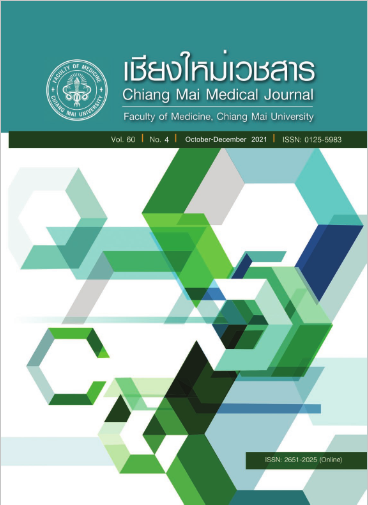Association between work characteristics and musculoskeletal disorders among perioperative nursing staffs
Main Article Content
Abstract
Objectives To investigate the association between work characteristics and musculoskeletal disorders among perioperative nursing staffs.
Methods The descriptive correlational research was conducted among 186 nursing personnel who work in the operating room in a tertiary care hospital. Data were collected using a self-report questionnaire comprised 3 parts including 1) personal and work data 2) perceived of work characteristics measured by Job Description Questionnaire (JDQ) of Sheikhzadeh et al. and 3) musculoskeletal disorders occurrence measured by Standardized Nordic Questionnaire (SNQ). Data were analyzed using descriptive statistic and Chi-Square test.
Results The finding indicated that the occurrence of musculoskeletal disorders among perioperative nursing staffs during the 7-day was 71.8%. The most frequently reported were shoulder, low back and knee (47.8%, 44.4%, and 38.2%, respectively). The occurrence of musculoskeletal disorders during the 12-month was 83.9%. The most frequently reported were low back, shoulder and knee (60.6%, 60.0%, and 52.8%, respectively). There were significant positive associations between musculoskeletal disorders reported within 7-day and 12-month period and work characteristics include working with twisting of wrists, overexertion of hands or arms, and repetitive movement (p <.05).
Conclusions Perioperative nursing personnel are at risk of developing musculoskeletal disorders. Testing the relationship was found that job characteristics were significantly associated with musculoskeletal disorders. Implementing programs or activities to reduce or prevent the occurrence of musculoskeletal disorders in these groups should be considered.
Article Details

This work is licensed under a Creative Commons Attribution-NonCommercial-NoDerivatives 4.0 International License.
References
Buckle P. Ergonomics and musculoskeletal disorders: overview. Occup Med. 2005;55: 164-7.
Hunter B, Branson M, Davenport DYMA. Saving costs, saving health care providers’ backs, and creating a safe patient environment. Nurs Econ. 2010;28:130-4.
Lin PH, Tsai YA, Chen WC, Huang SFYM. Prevalence, characteristics, and work-related risk factors of low back pain among hospital nurses in Taiwan: a cross-sectional survey. Ijomeh. 2012;25:41-4.
Ngammuang P, Suthakorn W. Ergonomic risk factors associated with musculoskeletal disorders among physical therapists at community hospitals. Health Region 1. 2019;49:325-38 (in Thai)
vannajak TP, Sae-Lee D, Jorns PT, Boonprakob Y. Neck pain relate with working posture in dentists. J Med Tech Phy Ther. 2019;31:85-92. (in Thai)
Soylar P, Özer A. Evaluation of the prevalence of musculoskeletal disorders in nurses:A systematic review. Medicine Science. 2018;7:479-85.
Ellapen TJ. Narsigan, S. Work related musculoskeletal disorders among nurses:Systematic review. J Ergonomic. 2014;S4:S4-003.
Suthipan S, Chantawong C, Leelukkanaveera Y. Risk factors of musculoskeletal disorders in practical nurses in private hospitals, eastern region (2020). [cited 2021 Jan 13]. Available from http://ohnde.buu.ac.th/upload/file/uploadd235b2f3e79588e64d806a6b2cfc2f3f.pdf.
Munabi IG, Buwembo W, Kitara DL, Ochieng J, Nabirye RC, Mwaka ES. Musculoskeletal disorders among nursing staff:a comparison of five hospitals in Uganda. Pan Afr Med J. 2014; 17:81.
Sheikhzadeh A, Gore C, Zuckerman JD, Nordin M. Perioperating nurses and technicians’ perceptions of ergonomic risk factors in the surgical environment. Appl Ergon. 2009;40:833-9.
Choobineh A, Movahed M, Tabatabaie SH, Kumashiro M. Perceived demands and musculoskeletal disorders in operating room nurses of Shiraz city hospitals. Ind Health. 2010;48:74-84.
Vural F, Sutsunbuloglu E. Ergonomics:An important factor in the operating room. J Perioper Pract. 2016;26:174-8.
Bakola H, Zyga S, Stergioulas A, Kipreos G, Panoutsopoulos G. musculoskeletal problems among Greek perioperative nurses in regional hospitals in southern Peloponnese: Musculoskeletal problems in perioperative nurses. Adv Exp Med Biol. 2017;989:21-37.
Butler RJ, Johnson WGYM. Adjusting rehabilitation costs and benefits for health capital: the case of low back occupational injuries. J Occup Rehabil. 2010;20:90-103.
Gropelli TMP, Corle K. Nurses’ and therapists’ experiences with occupational musculoskeletal injuries. AAOHN J. 2010;58:159-66.
Watson SD. Perioperative safety. Missouri: Mosby Elsevier; 2011.
Intranon K. Ergonomics. 3rd ed. Bangkok: Chulalongkorn University Press. 2016. (in Thai)
Krejcie RW, Morgan DW. Determining sample size for research activities. Educ Psychol Meas. 1970;30:607-10.
Kuorika BJ, Kilbom A, Vinterberg H, Sorensen FB. Standardized Nordic Questionnaires for the analysis of musculoskeletal symptom. Appl Ergon. 1987;18:233-7.
Kantiya N. Work-related musculoskeletal disorders and related factors among professional nurses [Thesis Master of Nursing Science (Occupational Health Nursing), Graduation School]. Chiang Mai, Chiang Mai University; 2009. (in Thai)
Simonsen GJ, Arvidsson I, Nordander C. Ergonomics in the operating room. Work. 2012;41 (Suppl 1):5644-6.
Meijsen P, Aug HJJKY. Work-related musculoskeletal disorders of perioperative personnel in the Netherlands. AORN J. 2007;86:193-208.
Cavallari JM, Ahuja M, Dugan AG, Meyer JD, Simcox N, Wakai S, Garza JL. Differences in the prevalence of musculoskeletal symptoms among female and male custodians. Am J Ind Med. 2016;59:841–52.
Okunribido O, Wynn T, Lewis D. Are older workers at greater risk of musculoskeletal disorders in the workplace than young workers? - A literature review. Occup Ergon. 2011;10: 53-68.
Rodrigues E, Gomes A, Tanhoffer A, Leite N. Effects of exercise on pain of musculoskeletal disorders: a systematic review. Acta Ortop Bras. 2014;22:334-8.
Canadian centre for Occupational Health and safety. OSH Answers Fact. Sheets. (2021). [Internet]. [cited 2020 Oct 27]. Available from https://www.ccohs.ca/oshanswers/diseases/rmirsi.html
Albayrak A. Ergonomics in the operating room transition from open to image-based surgery [dissertation]. Delft: Delft University of Technology; 2008.
Taghinejad H, Azadi A, Suhrabi Z, Sayedinia M. Musculoskeletal disorders and their related risk factors among Iranian nurses. Biotech Health Sci. 2016;3:e34473.
Gregory DE, Callaghan JP. Prolonged standing as precursor for the development of low back discomfort: an investigation of possible mechanisms. Gait Posture. 2008;28:86-92.
Coenen P, Willenberg L, Parry S, Shi JW, Romero L, Blackwood DM, Maher CG, Healy GN, Dunstan DW, Straker LM. Associations of occupational standing with musculoskeletal symptoms:a systematic review with meta-analysis. Br J Sports Med. 2018;52:176-83.


